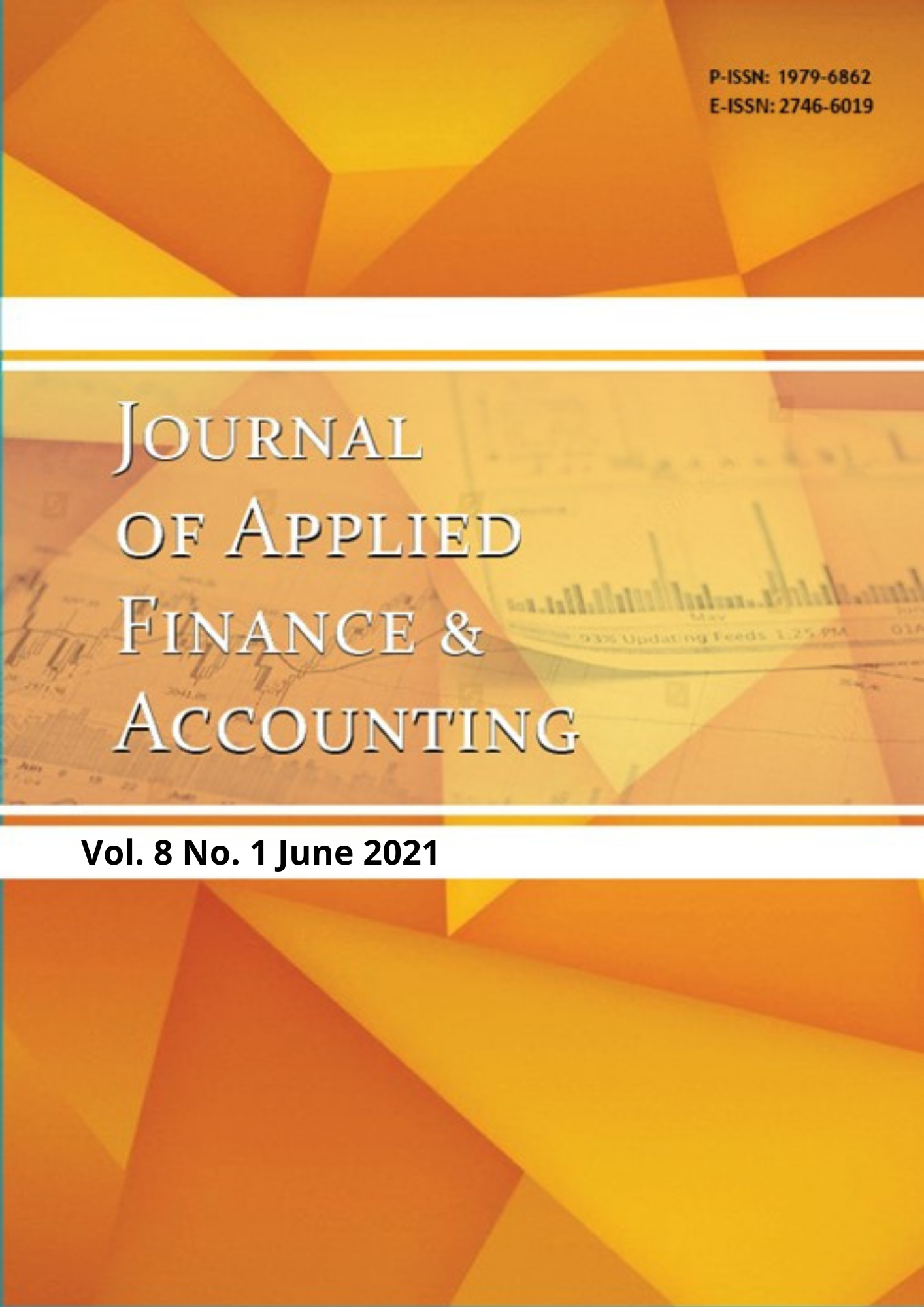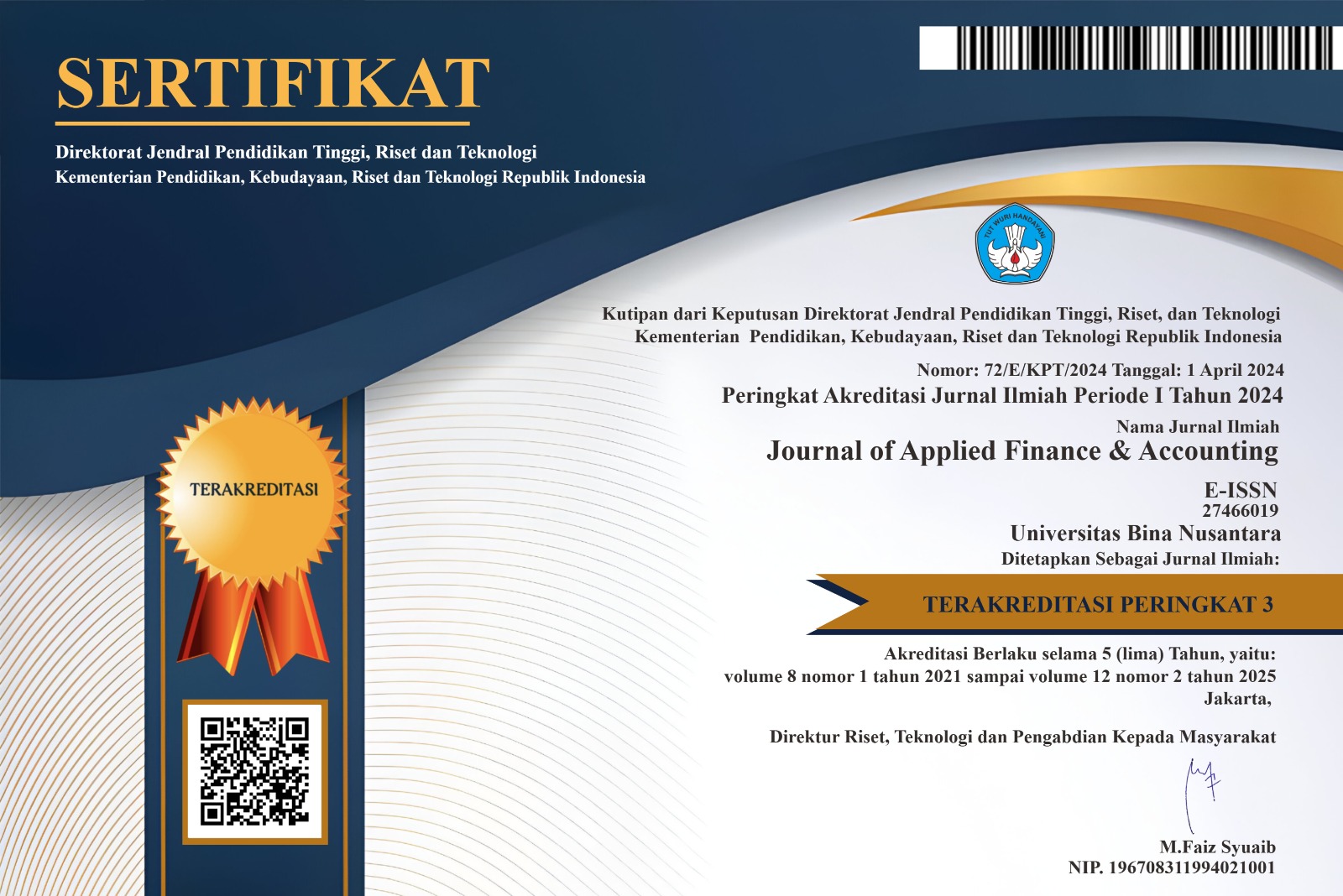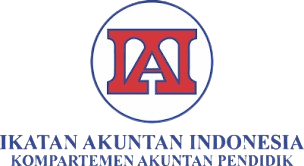AN EVALUATION OF INTERNAL CONTROL IMPLEMENTATION: A CASE STUDY OF EXHIBITION COMPANY
DOI:
https://doi.org/10.21512/jafa.v8i1.8122Keywords:
Revenue Cycle, Internal Control, Evaluation, COSO FrameworkAbstract
This study aimed to evaluate the revenue cycle implemented in the Exhibition Company to identify the weaknesses and limitations of internal controls related to revenue cycles by referring to the COSO's Internal Control Framework. The study uses a qualitative descriptive approach by assessing the current revenue cycle implemented at the Exhibition Company and the internal control. The process of collecting data is through interviews and observation. Based on the evaluation, there are weaknesses in internal control in the revenue cycle applied by the company. This study indicates that the internal control is still not effective following the COSO framework, leading to the possibility of a fraudulent act in the company. Therefore, as its business continues growing, it is essential to focus more on its revenue cycle system and internal control to implement an effective and efficient procedure to support its operating performance. Furthermore, it suggests improvement as needed based on COSO's internal control framework to overcome the discovered potential weaknesses.
References
Adegboyegun, A. E., Ben-Caleb, E., Ademola, A. O., Oladutire, E. O., & Sodeinde, G. M. (2020). Internal control systems and operating performance: Evidence from small and medium enterprises (SMEs) in Ondo state. Asian Economic and Financial Review, 10(4), 469–479. https://doi.org/10.18488/journal.aefr.2020.104.469.479
Attah-Botchwey, E. (2018). Internal control as a tool for efficient management of revenue mobilization at the metropolitan, municipal and district assemblies in Ghana: A case study of Accra Metropolitan Assembly. American International Journal of Contemporary Research, 8(1), 29–36.
Ayam, J. R. A. (2015). An Analysis of Revenue Cycle Internal Controls in Ghanaian Universities. Case Studies in Business and Management, 2(2), 1. https://doi.org/10.5296/csbm.v2i2.7320
Büyükçoban, A., & Ünkaya, D. G. (2016). The Role of Internal Control to Prevent the Fraud in Small and Micro Enterprises: A Turkish Perspective. IOSR Journal of Business and Management, 18(10), 1–5. https://doi.org/10.9790/487x-1810010105
Çika, N. (2018). Development of Internal Controls in Small and Medium Enterprises - Case of Albania. European Journal of Marketing and Economics, 1(1), 53–62. https://doi.org/10.26417/ejme.v1i1.p53-62
Foster, B. P., McClain, G., & Shastri, T. (2010). Impact on pre-and post-sarbanes oxley users’ perceptions by incorporating the auditor’s fraud detection responsibility into the auditor’s internal control report. Research in Accounting Regulation, 22(2), 107–113. https://doi.org/10.1016/j.racreg.2010.07.005
Graham, L. (2015). Internal Control Audit and Compliance: Documentation and Testing Under the New COSO Framework (1st ed.). Wiley.
Lawson, B. P., Muriel, L., & Sanders, P. R. (2017). A survey on firms’ implementation of COSO’s 2013 Internal Control–Integrated Framework. Research in Accounting Regulation, 29(1), 30–43. https://doi.org/10.1016/j.racreg.2017.04.004
Liu, C., Lin, B., & Shu, W. (2017). Employee quality, monitoring environment and internal control. China Journal of Accounting Research, 10(1), 51–70. https://doi.org/10.1016/j.cjar.2016.12.002
Monday, J. U., Inneh, G. E., & Ojo, V. O. (2014). Internal Controls and Operating Performance of Small Businesses in. International Conference on Accounting, Finance and Management, March, 237–256.
Rae, K., Sands, J., & Subramaniam, N. (2017). Associations among the Five Components within COSO Internal Control-Integrated Framework as the Underpinning of Quality Corporate Governance. Australasian Accounting, Business and Finance Journal, 11(1), 28–54. https://doi.org/10.14453/aabfj.v11i1.4
Romney, Marshall B. & Steinbart, P. J. (2006). Accounting Information Systems (10th ed.). Pearson Education Limited.
Saunders, M., Lewis, P. and Thornhill, A. (2016). Research Methods for Business Students. (7th ed.). Pearson, Harlow.
Schandl, A., & Foster, P. L. (2019). COSO Internal Control - Integrated Framework: An Implementation Guide for the Healthcare Industry. COSO - Committee of Sponsoring Organizations of the Treadway Commission, January, 5. https://www.coso.org/Documents/COSO-CROWE-COSO-Internal-Control-Integrated-Framework.pdf
Stringer, C., & Carey, P. (2002). Internal Control Re-design: An Exploratory Study of Australian Organisations. Accounting, Accountability and Performance, 8(2), 61–86.
The Committee of Sponsoring Organizations of the Treadway Commission. (2013). Inter n al Co n t ro l — I n te g rate d F ra mewo rk E xe cu tive S u mmar y. Coso, May, 1–20. https://www.coso.org/Pages/ic.aspx
Wicaksono, A. (2013). Evaluasi Pengendalian Internal Siklus Pendapatan Pada PT X. Binus Business Review, 4(2), 676–686. https://doi.org/10.21512/bbr.v4i2.1381
Downloads
Published
Issue
Section
License
Authors who publish with this journal agree to the following terms:
Authors retain copyright and grant the journal right of first publication with the work simultaneously licensed under a Creative Commons Attribution License that allows others to share the work with an acknowledgement of the work's authorship and initial publication in this journal.
Authors are able to enter into separate, additional contractual arrangements for the non-exclusive distribution of the journal's published version of the work (e.g., post it to an institutional repository or publish it in a book), with an acknowledgement of its initial publication in this journal.
Authors are permitted and encouraged to post their work online (e.g., in institutional repositories or on their website) prior to and during the submission process, as it can lead to productive exchanges, as well as earlier and greater citation of published work (See The Effect of Open Access).





